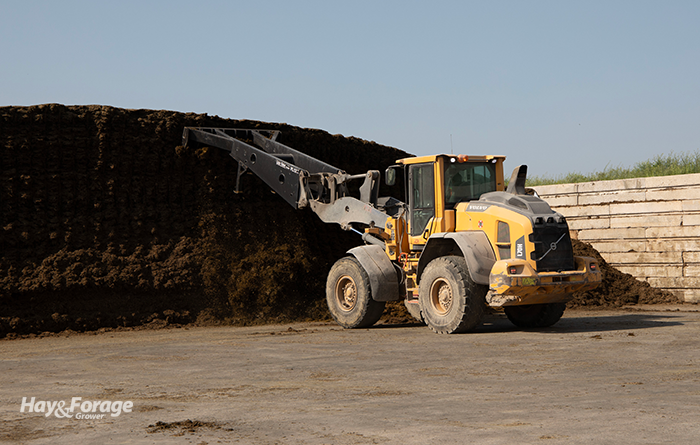
Best corn silage feeding practices include removing only a day’s worth of material from storage to limit spoilage and ensure animals always receive fresh feed. But in order to maintain this feeding routine, farmers must have a sound assessment of their silage quality and quantity.
A common rule of thumb is to wait until Christmas before opening bunkers, bags, and piles that were packed and sealed in late summer, allowing roughly three months for adequate fermentation. With this in mind, Gail Carpenter with Iowa State University encourages farmers to feed current corn silage supplies in such a way to last until Christmas the following year. The extension dairy specialist suggests farmers who start managing their corn silage inventory now will thank their future selves.
“The silage you put up this fall will be the foundation of your feeding program for months to come,” Carpenter asserts. “Taking the time to plan, measure, and monitor your inventory now can save you stress later and ensure your cows are getting consistent, high-quality feed.”
Checking it twice
Carpenter notes a corn silage inventory can come in handy whether supplies are above or below what was anticipated. For instance, with more corn silage available, farmers may be able to tweak dairy rations and raise the inclusion rate of the high-energy feedstuff. On the other hand, knowing in advance that corn silage supplies will run short allows more time to source other forages or purchase supplements.
“Planning ahead gives you options, whether that means stretching a tight supply or taking advantage of an abundant one,” Carpenter writes. “Working closely with your nutritionist is the best way to keep your plan on track.”
In addition to taking inventory, Carpenter advises farmers to be diligent in their silage handling and feeding to reduce waste and preserve quality. She provides the following list of action items.
• Minimize shrink at harvest and during storage. Fill and pack silage at adequate rates and consider covering bunkers and piles with oxygen barriers. Keep storage areas well maintained to mitigate spoilage.
• Reduce shrink at feedout. Home in on daily feeding practices. Clean up silage removal, leave a clean face on the removal area, and deliver feed quickly to limit waste.
• Keep inventory. Determine how much silage you have available and record feeding rates to calculate how long supplies will last.
• Monitor dry matter. Silage dry matter will vary throughout the storage pile and in the feedbunk. Check moisture levels regularly to ensure you are feeding cows the correct amount of dry matter.
Carpenter contends that the best way to ensure silage management is effective is to make a routine out of checking dry matter at least once per week, whether using a spreadsheet, ration software, or a handwritten list.
When it comes to checking silage inventory, there are three critical factors to consider: pile or structure dimensions, average dry matter content, and storage density. Carpenter recommends measuring density with the feedout method.
Allocate a section of the pile or structure to feed for several days and find the volume of silage in that section. Then, record the weight and dry matter of the silage removed during the trial period. Calculate density by dividing silage weight by storage volume. “If you use this method, always keep a smooth silage face to maintain safety and accuracy,” Carpenter asserts.
“Corn silage is one of the most valuable feeds on the farm. Manage it well to maximize this investment,” Carpenter concludes. “A little effort spent on planning now can go a long way toward a smooth feeding season in 2026.”

